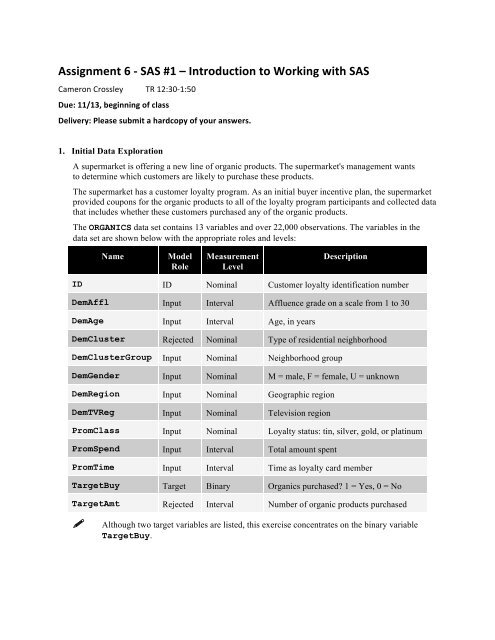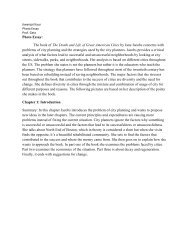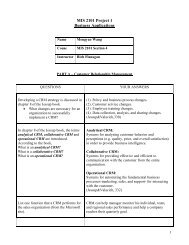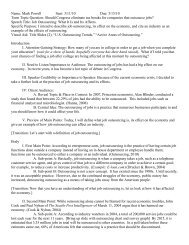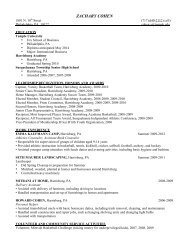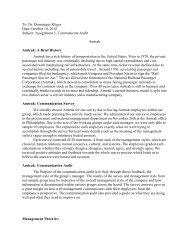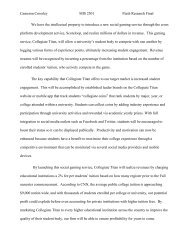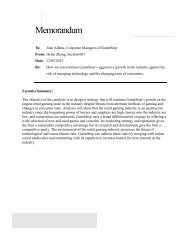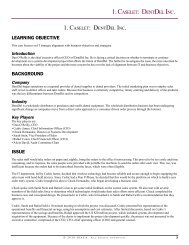Assignment 6 -â SAS #1 â Introduction to Working ... - Temple Fox MIS
Assignment 6 -â SAS #1 â Introduction to Working ... - Temple Fox MIS
Assignment 6 -â SAS #1 â Introduction to Working ... - Temple Fox MIS
- No tags were found...
Create successful ePaper yourself
Turn your PDF publications into a flip-book with our unique Google optimized e-Paper software.
<strong>Assignment</strong> 6 -‐ <strong>SAS</strong> <strong>#1</strong> – <strong>Introduction</strong> <strong>to</strong> <strong>Working</strong> with <strong>SAS</strong> Cameron Crossley TR 12:30-‐1:50 Due: 11/13, beginning of class Delivery: Please submit a hardcopy of your answers. 1. Initial Data ExplorationA supermarket is offering a new line of organic products. The supermarket's management wants<strong>to</strong> determine which cus<strong>to</strong>mers are likely <strong>to</strong> purchase these products.The supermarket has a cus<strong>to</strong>mer loyalty program. As an initial buyer incentive plan, the supermarketprovided coupons for the organic products <strong>to</strong> all of the loyalty program participants and collected datathat includes whether these cus<strong>to</strong>mers purchased any of the organic products.The ORGANICS data set contains 13 variables and over 22,000 observations. The variables in thedata set are shown below with the appropriate roles and levels:NameModelRoleMeasurementLevelDescriptionID ID Nominal Cus<strong>to</strong>mer loyalty identification numberDemAffl Input Interval Affluence grade on a scale from 1 <strong>to</strong> 30DemAge Input Interval Age, in yearsDemCluster Rejected Nominal Type of residential neighborhoodDemClusterGroup Input Nominal Neighborhood groupDemGender Input Nominal M = male, F = female, U = unknownDemRegion Input Nominal Geographic regionDemTVReg Input Nominal Television regionPromClass Input Nominal Loyalty status: tin, silver, gold, or platinumPromSpend Input Interval Total amount spentPromTime Input Interval Time as loyalty card memberTargetBuy Target Binary Organics purchased? 1 = Yes, 0 = NoTargetAmt Rejected Interval Number of organic products purchasedAlthough two target variables are listed, this exercise concentrates on the binary variableTargetBuy.
a. Create a new diagram named Organics.b. Define the data set AAEM.ORGANICS as a data source for the project.1) Set the roles for the analysis variables as shown above.(You can go back and modify variable roles even after you complete the wizard by rightclickingon the Organics data source and selecting Edit Variables…)The variable DemClusterGroup contains collapsed levels of the variable DemCluster.Presume that, based on previous experience you believe that DemClusterGroup issufficient for this type of modeling effort. Set the model role for DemCluster <strong>to</strong> Rejected.Include a screen shot showing DemCluster is rejected (as on page 17 of the in-classexercise).2) Examine the distribution of the target variable TargetBuy. You can do this by clicking onthat variable in the Column Metadata (step 6 of 9 in the wizard) and then clicking theExplore but<strong>to</strong>n.What is the proportion of individuals who purchased organic products (hint: take a look at theMeans column in the “Sample Statistics” window)?ANSWER: 24%Mean = .2434 (This essentially means 1 out of every 4 people)
3) Finish the Organics data source definition.a. Add the AAEM.ORGANICS data source <strong>to</strong> the Organics diagram workspace.b. Explore the Organics data source and answer the following questions:Are there more males or more females in the sample? ANSWER: Females(Hint - plot DemGender using a bar chart)Include a screen shot showing the bar chart (see example in the in-class exercise).What is maximum age of the people in the sample? ANSWER: 79Plot DemAffl using a his<strong>to</strong>gram with 30 “X” bins. Based on that, is it more common <strong>to</strong> be veryaffluent (wealthy) or very poor?ANSWER: Very Poor


